Some of the most unique caterpillars can look cute or weird. Beautiful cute caterpillars live in North America and they represent various species that turn into moths and butterflies.
From vivid coloring to a fuzzy appearance, cute caterpillars can be found across various habitats. Spiny or weirdly-shaped, caterpillars can be spotted feeding on tree leaves and various plants.
Caterpillars can be green, brown, red, or black. Some have a shiny appearance while others are hairy.
However, some of the cutest caterpillars have a friendly appearance, such as the case caterpillar with eyespots.
Others have venomous spines which make them look dangerous and which may even cause dermatitis when handled with bare hands.
Weird caterpillars which change colors completely from one instar to another are found in the US.
Some also take on the colors of dead leaves or twigs, in a mimicry tactic that gives them a camouflaging appearance.
Some of the most beautiful caterpillars which are either cute or even weird-looking include species in North America as well as in warm areas around the tropics.
Table of Contents
1. Stinging Rose Caterpillar
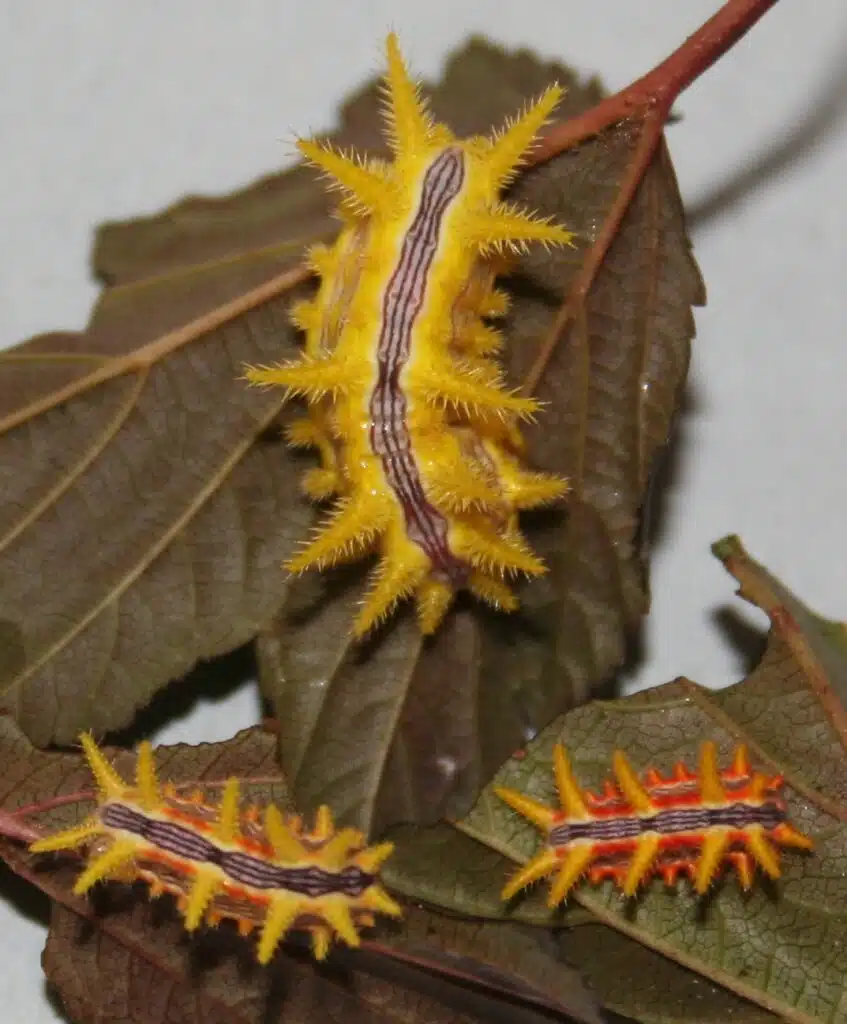
Eastern US states are the home to this weird caterpillar with its atypical look.
Apple and hickory are among the common host trees where this caterpillar can be spotted.
It has a multicolored body with either an orange or a green base color. This color covers a good part of its body and its numerous thick spines.
The species also shows black and white stripes across its mid-dorsal section.
As it grows, its thick spines start to grow smaller hairs that are like tiny weird spines.
While a beautiful caterpillar, The Stinging Rose Caterpillar (Parasa indetermina) shouldn’t be touched as it can trigger allergic reactions.
2. Paddle Caterpillar
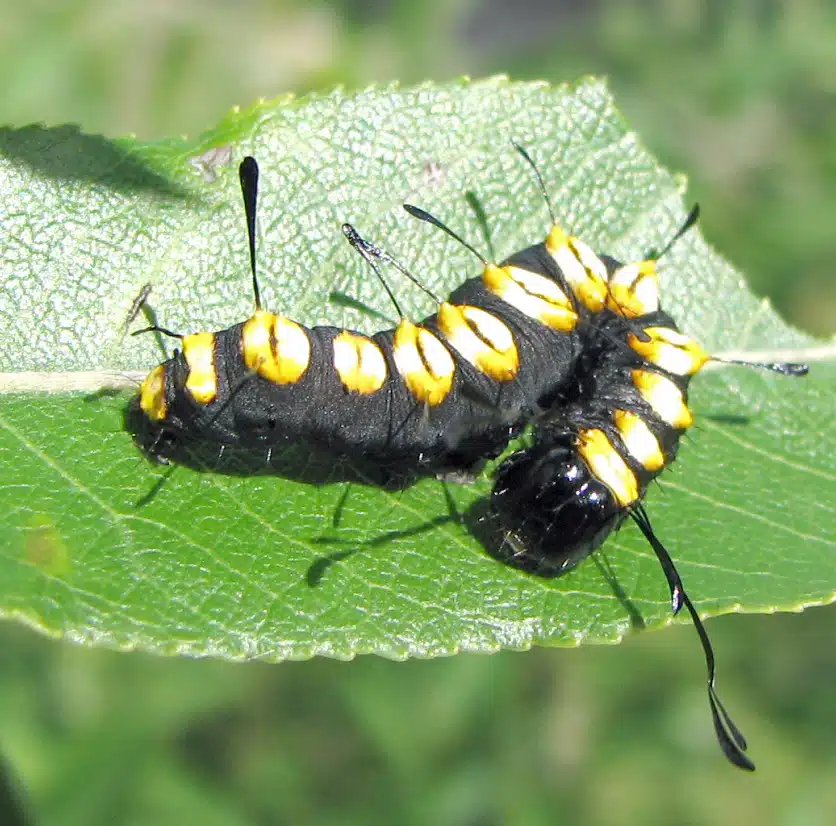
Paddle Caterpillars (Acronicta funeralis) are some of the most beautiful species in North America, with a unique look.
This caterpillar grows into a black species towards its last instar with yellow ring-like sections across its back.
Yellow eyespot formations are seen from its head to the anal plate.
A contrasting black and yellow caterpillar, The Paddle Caterpillar can be one of the species which may even seem poisonous to its predators.
The weird black caterpillar may be spotted feeding on the leaves of trees. It prefers apple, hickory, maple, and typical oak tree leaves that other caterpillars also eat.
3. Purple-crested Slug
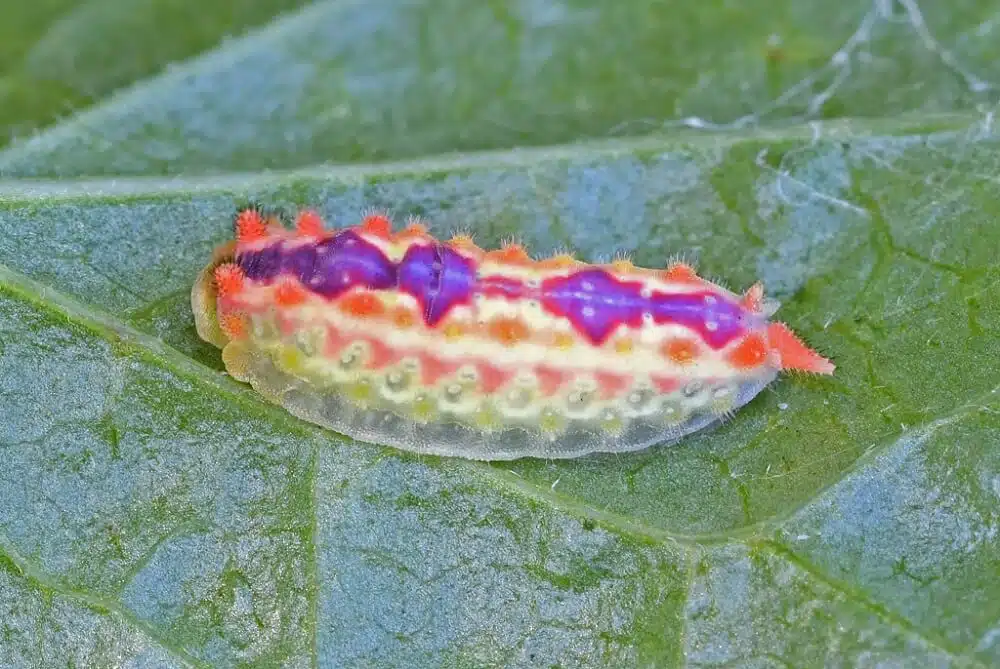
Eastern and Southeastern US territories are the home to this quirky caterpillar (Adoneta spinuloides).
The species is seen on linden and beech, among other types of trees as it feeds on living leaves.
Almost half of its body is green, which isn’t atypical on caterpillars. However, it’s the lower part of the Purple-crested Slug’s body that is green below.
Its dorsal side is dominated by vivid colors such as yellow and red-brown.
Small orange spines are also seen on the species, highly similar to its prolegs.
It almost looks as if this species is upside down.
4. Spun Glass Slug
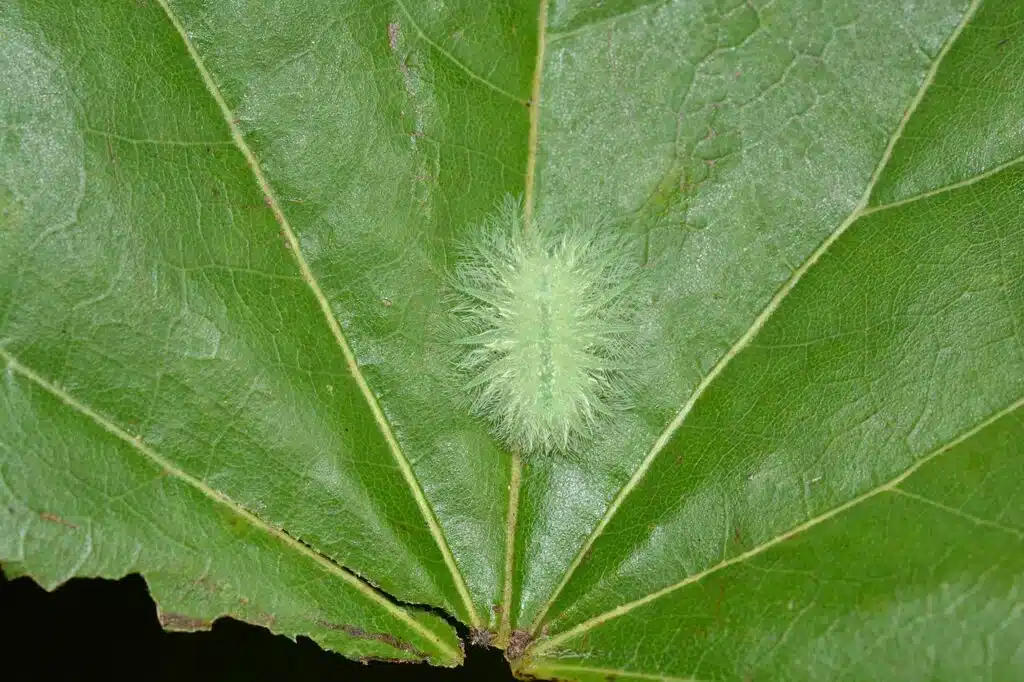
Oak and beech are the typical hosts of an atypical caterpillar, The Spun Glass Slug (Isochaetes beutenmuelleri).
This is one of the species with large spine-like formations covered in shorter sharpened spines.
The uniform green coloring is specific to this species. It can be found across large tree leaves but its green color often camouflages it in front of its predators.
As it grows, the caterpillar remains green, but in dual nuances. The lighter green is specific to its spines while its body is mostly dark green.
The hairs or spines of the species are poisonous. They can cause skin-level pain when touched.
Rashes and red skin patches are also common with the species.
5. Heiligbrodt’s Mesquite Moth Caterpillar
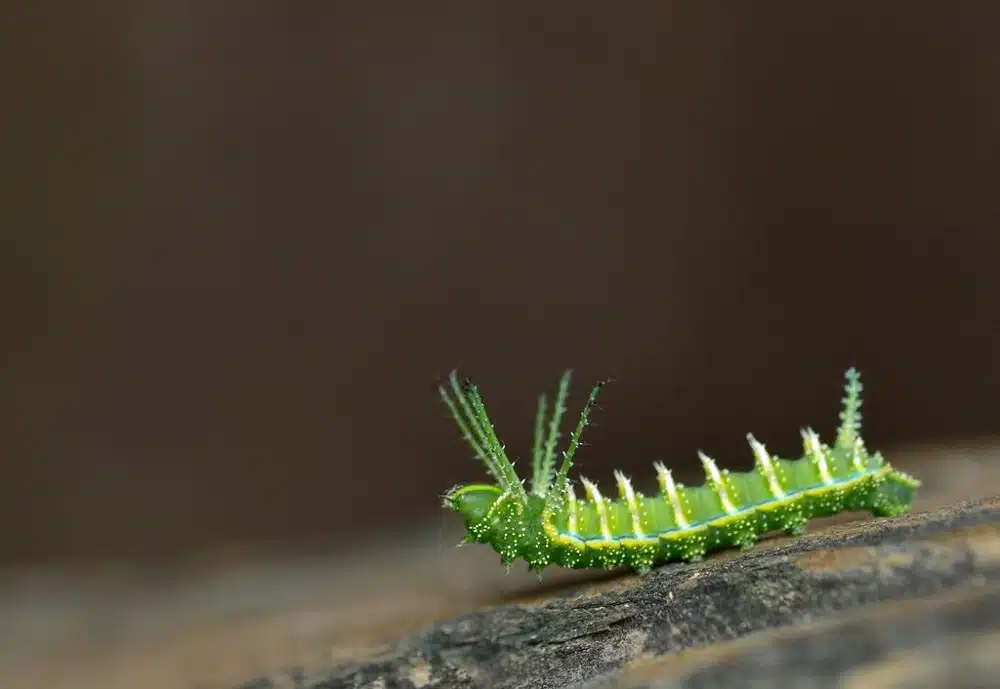
This species (Syssphinx heiligbrodti) is one of the rarest types of caterpillars in the US. It also has a weird appearance with 6 horn-like tubercles behind its head.
4 of these spines are black while the other 2 are yellow.
Smaller white projections are also seen in 2 rows across its body.
This species has a base green color with additional black stripes along the body. These turn into white and red stripes in their later growth stages.
Apart from its weird appearance, the caterpillar also has a limited habitat. It can only be found in Southern Texas and Mexico.
6. Black-etched Prominent Moth Caterpillar
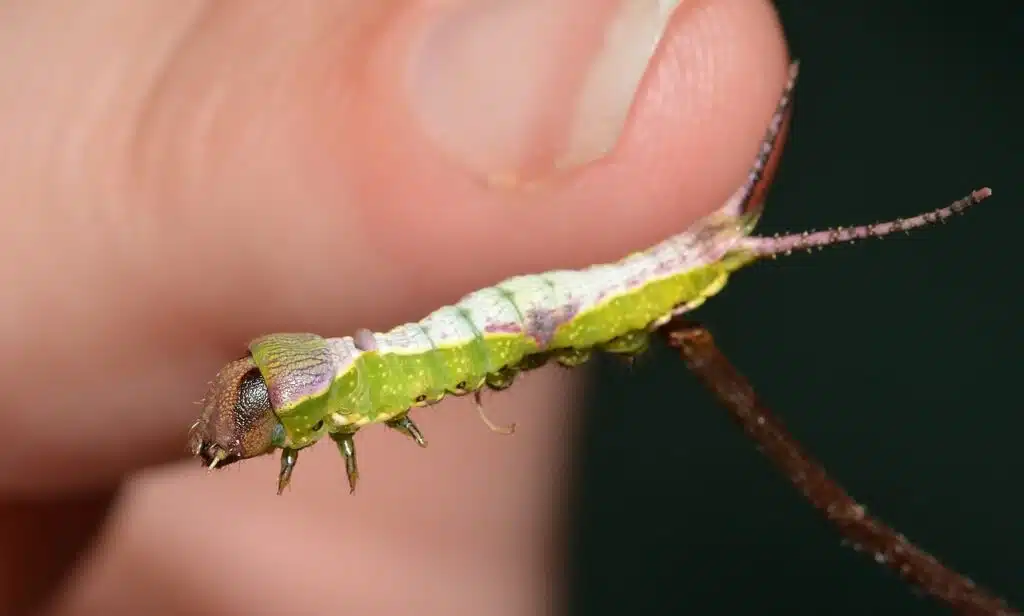
Poplar is one of the main hosts of the Black-etched Prominent Moth Caterpillar (Tecmessa scitiscripta).
A green-and-white color combination is specific to this cute species.
It has a green base color on the lower part of its body and its ventral side. The white coloring is specific to its dorsal side.
Red stripes are seen along the wide large dorsal area of the species.
Long cerci which resemble tails are also spotted on the species after it molts.
Small eyespots or dots are also visible along the sides of the species as it grows.
One of the smallest caterpillars in North America, this species also has long prolegs and a dark, typically green and brown head.
7. Gaudy Sphinx Caterpillar
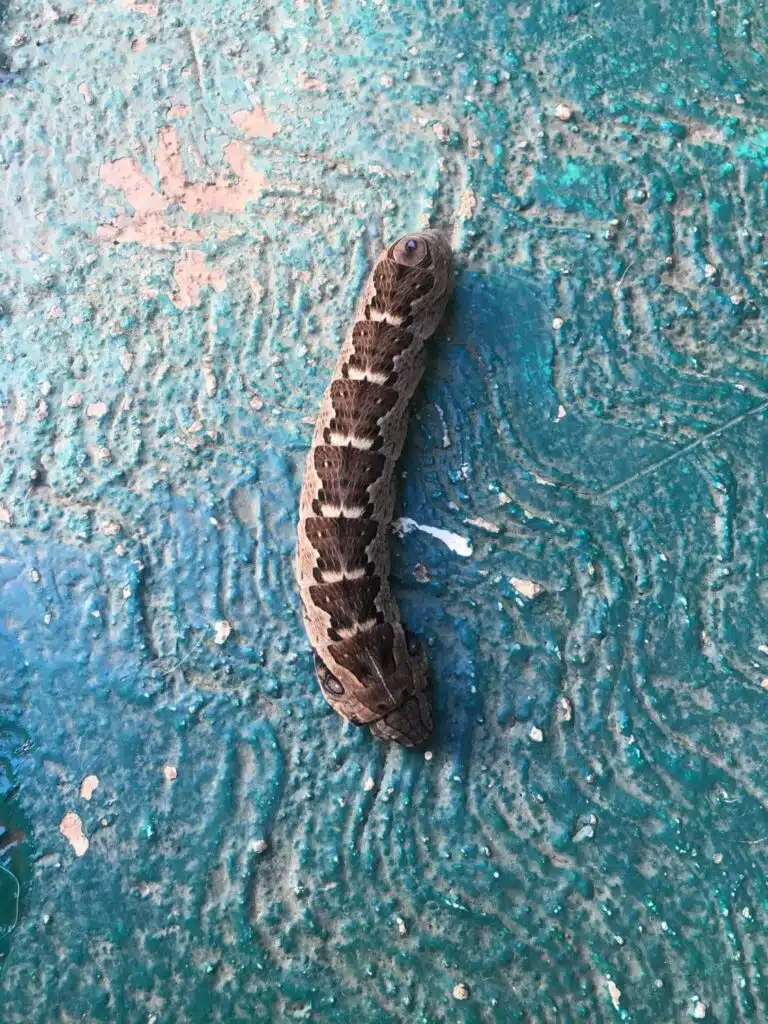
This caterpillar (Eumorpha labruscae) is one of the weirdest species in North and South America.
It takes on the appearance of a small snake, which may help it appear like a dangerous species.
Brown-to-gray coloring is specific to the species. Gray lateral colors and a wide brown dorsal section are specific to the species.
The head of the species is wider than the rest of the body. It has a gray-brown color and 2 large eyespots on its head.
This caterpillar even has a fake nostril which makes it look unlike any other species of caterpillar in the Eastern parts of North America.
8. Jewel Caterpillar
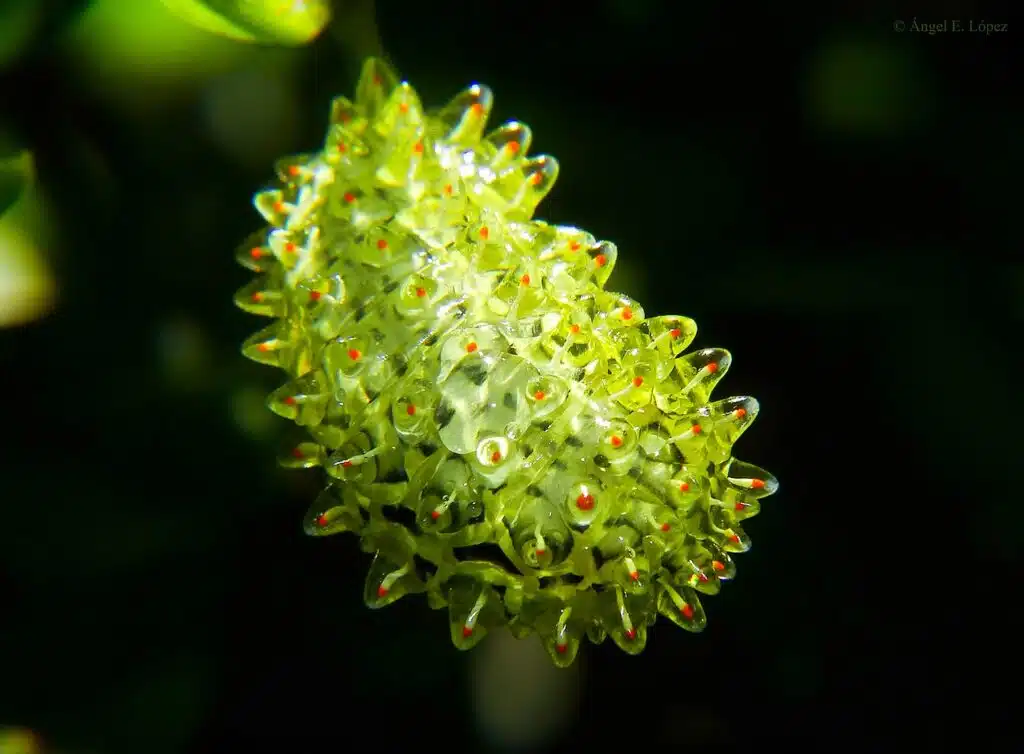
Multiple countries in Central America are the home of the Jewel Caterpillar (Acraga coa).
This is a species marked by a jewel-like appearance that impresses with its beautiful almost transparent coloring.
The caterpillar goes through multiple color changes from white to orange and green. It has small rounded tubercles which are slightly transparent but which may also have a solid color.
Jewel Caterpillars can also be seen in a combination of yellow/orange sections with green sections in their late growth stages after it molts.
Terminalia trees and coffee are among its atypical hosts.
9. Common Archduke Caterpillar
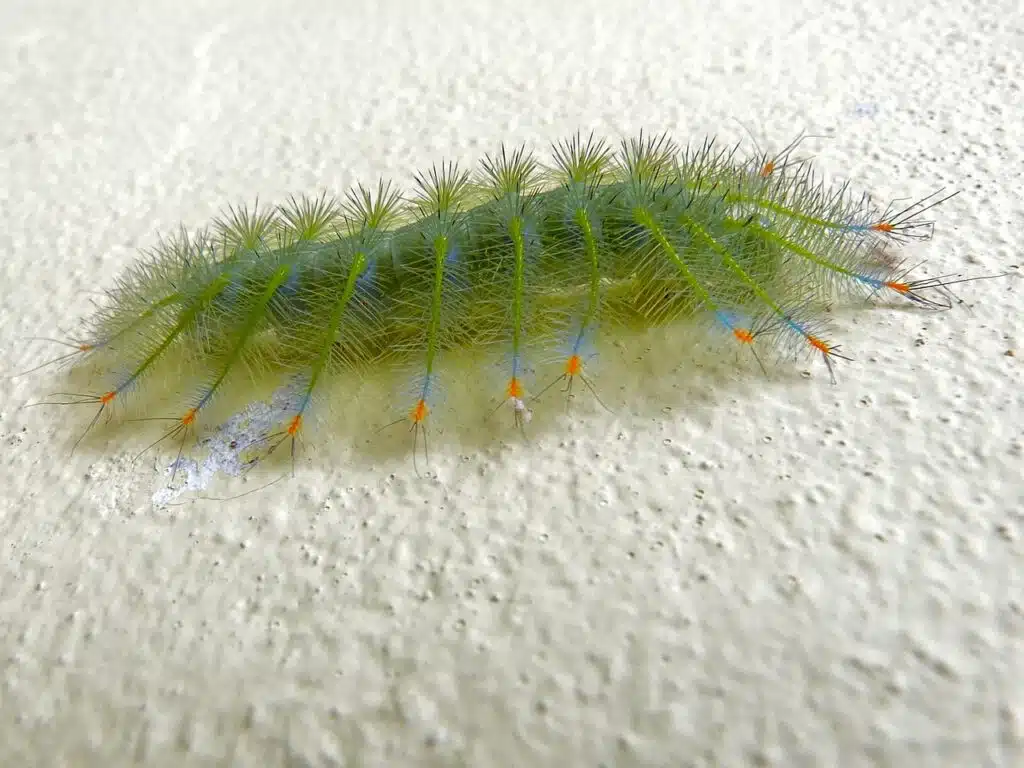
A rare species (Lexias pardalis) around India, this type of caterpillar has an atypical feeding habit.
An atypical look is also specific to the caterpillar.
A dark green body is specific to the species. Lighter green tubercles and hairs are further seen in this species.
The tips of these hairs are also orange.
This fuzzy-looking caterpillar is among the species that may also go through various green nuance changes as it molts.
Some of these caterpillars may be spotted feeding on the trees of saptrees in the summer.
10. Blue Nawab Caterpillar
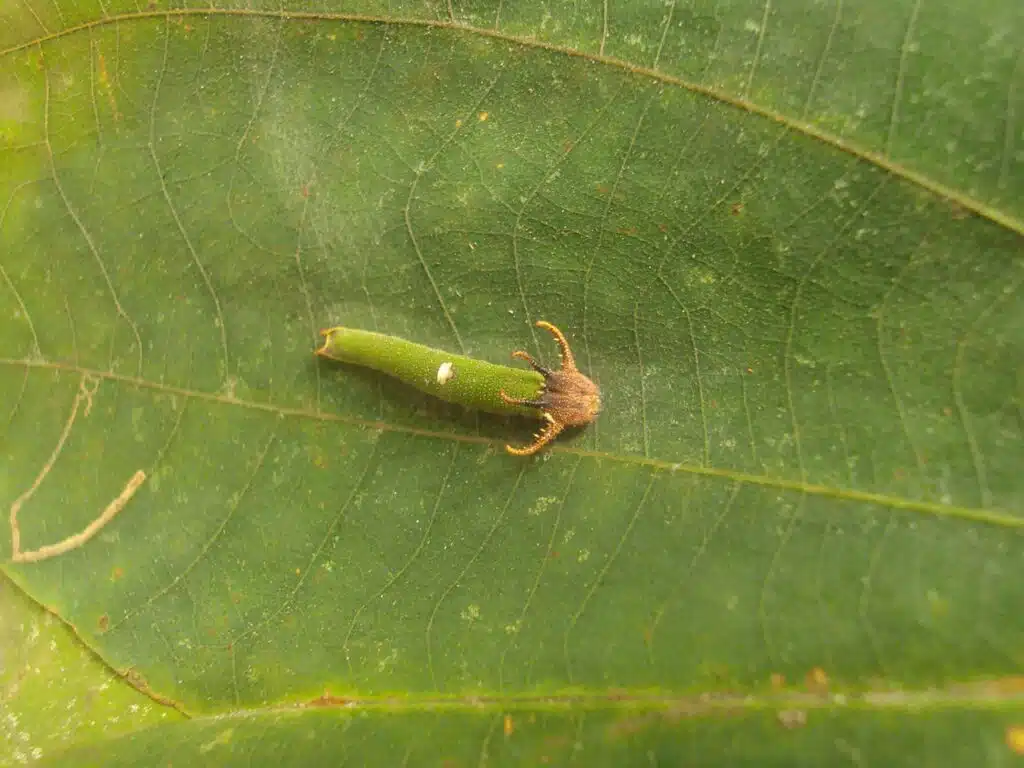
Tropical and subtropical regions all around the world provide a warm and humid environment for the Blue Nawab Caterpillar (Polyura schreiber).
This is a species often compared to dragons, given it has a unique horned appearance.
Caterpillars of this type are known for having a pale green body color. They have large heads with 4 horns.
These horns are bent backward, which is where their comparison to mythical dragons comes from.
Brown is specific to its head while its horns are either brown or black.
11. Moth Butterfly Caterpillar
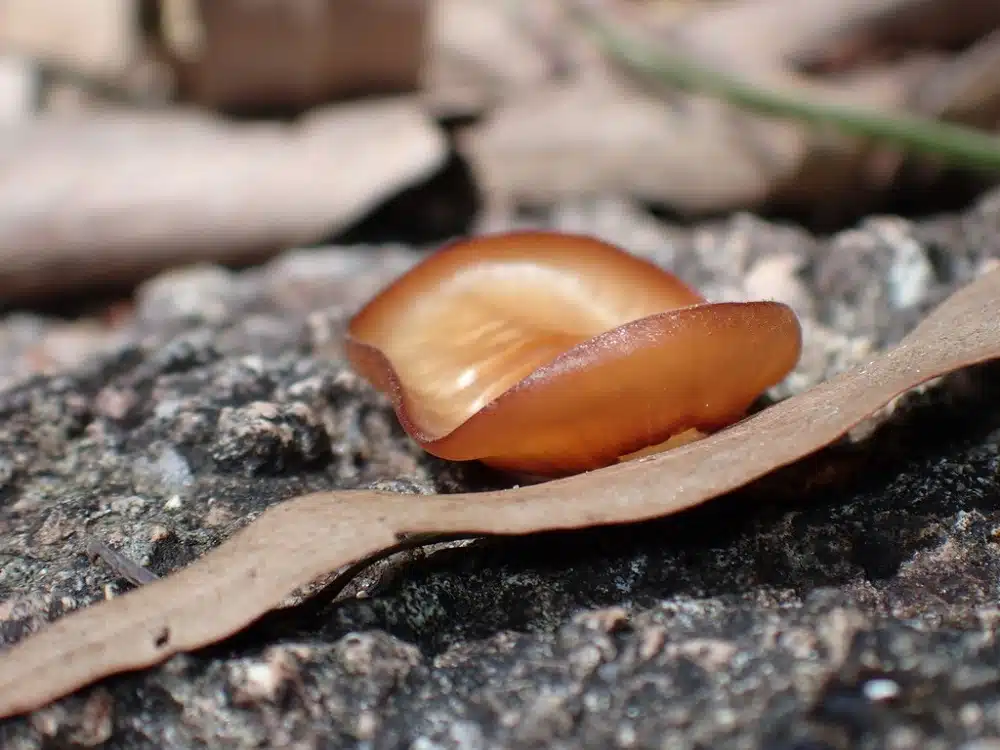
One of the weird caterpillars is the Moth Butterfly Caterpillar (Liphyra brassolis).
This caterpillar looks like a slug and it even has a flattened rear end, similar to slugs.
Orange to brown upper coloring is specific to the species which also has a white lower color.
Moth Butterfly Caterpillars take on the appearance of slugs which aren’t often eaten by predators who like caterpillars due to their foul taste.
A mimicking appearance is also specific to the emerged moth. It takes on the appearance of a dead leaf.
12. Laugher Moth Caterpillar
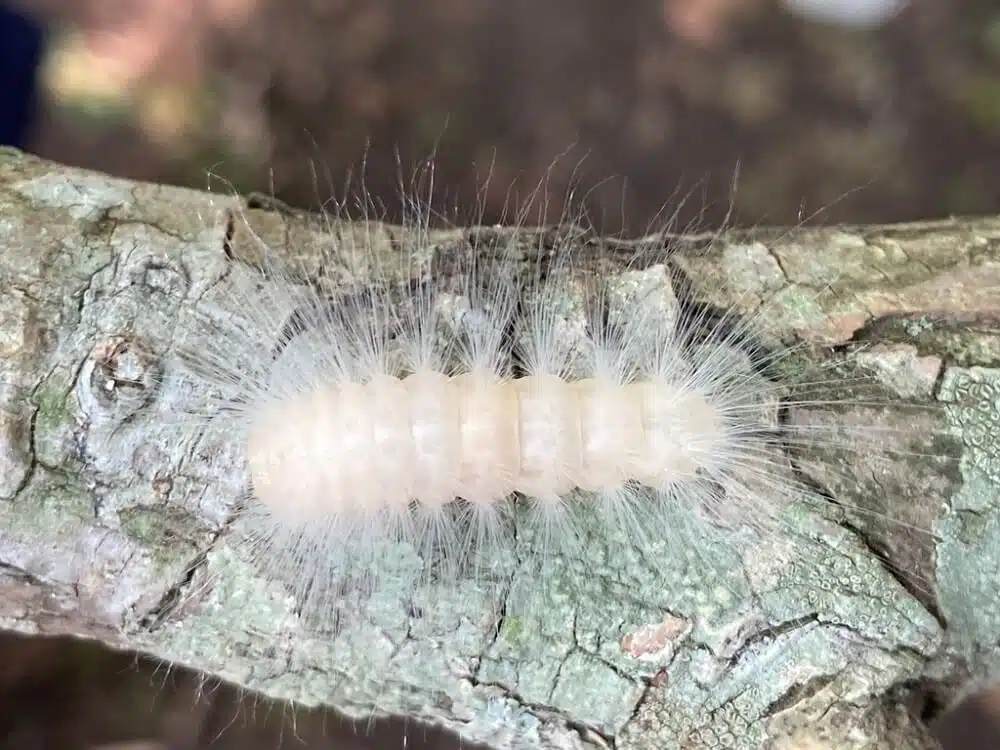
A beautiful white caterpillar, The Laugher Moth Caterpillar (Charadra deridens) is a species native to Eastern US states.
The pure white coloring is specific to this species. Its ventral color might be cream or cream-yellow after its last molt.
Long white hairs cover the dorsum of the species. These hairs are upward-facing and they may be irritating to some of their predators.
While not irritating to humans, touching these caterpillars may lead to mild rash-like symptoms.
13. Lobster Moth Caterpillar
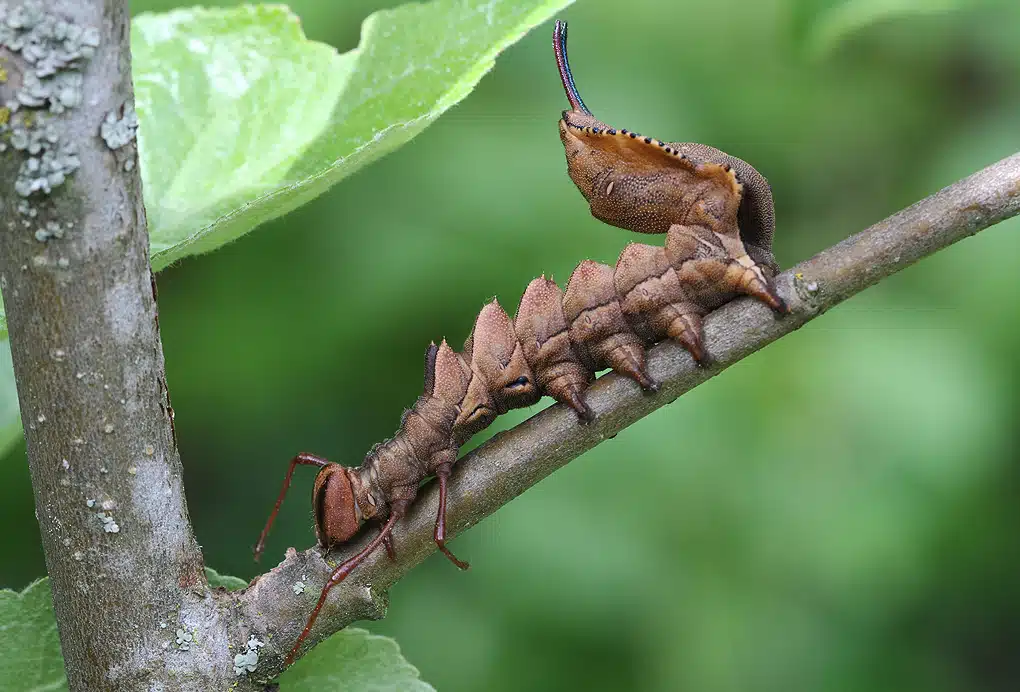
An irregular shape and atypical coloring are specific to The Lobster Moth Caterpillar (Stauropus fagi).
This is a species with a numerous presence on its hosts, which it can defoliate.
The caterpillar has light brown-red coloring or salmon coloring. Its prolegs are mostly red or red-brown.
White diagonal bands are also seen on the sides of its body.
A longhorn that resembles a tail is also characteristic of the tip of its abdomen.
Taking on the coloring of dead leaves, this type of caterpillar may escape predation, and management techniques are required to save its acer or chestnut hosts.
14. Anaxidia lozogramma Caterpillar
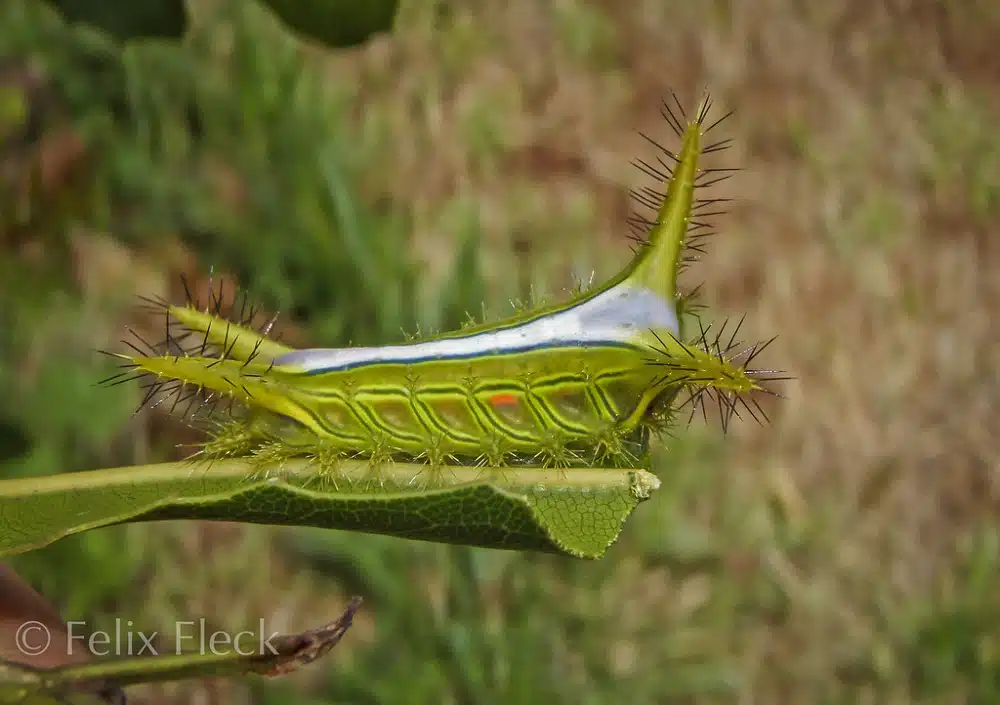
Living across Australia, this caterpillar is a species characterized by a brightly-colored body.
A green or yellow-to-green neon-like body color is specific to the species.
A spiny appearance is also specific to the species. Long greenhorns are seen on both sides of the caterpillar.
Its mid-dorsal section is mostly white and even partially red. It features blue bordering and yellow colors towards the head and the rear end.
A weird look is also specific to the eggs of this species, which are hairy.
15. Monkey Slug
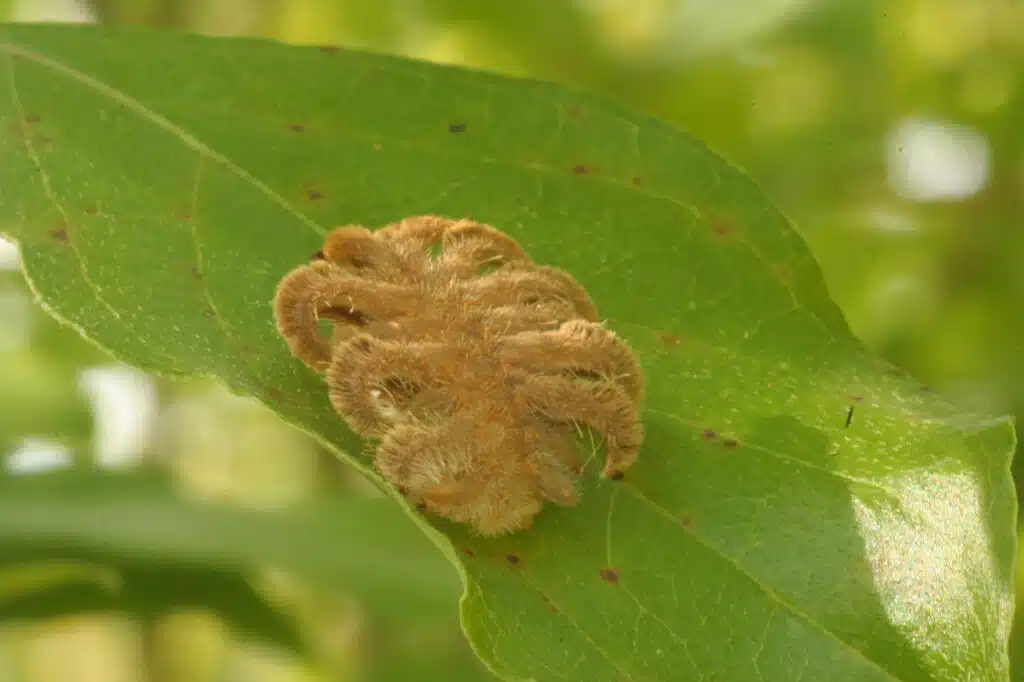
Monkey Slug Caterpillars (Phobetron pithecium) are some of the most atypical and weird caterpillars in the world.
No other species resembles this type of caterpillar.
A slim body with similarly-sized and curled projections is specific to this caterpillar. This is a species that is often taken as a spider while others compare it to molted skin.
The underside of the caterpillar is mostly yellow.
While it seems the projections are actual legs, they cannot be used by the caterpillar for movement.
16. Planthopper Parasite Moth Caterpillar
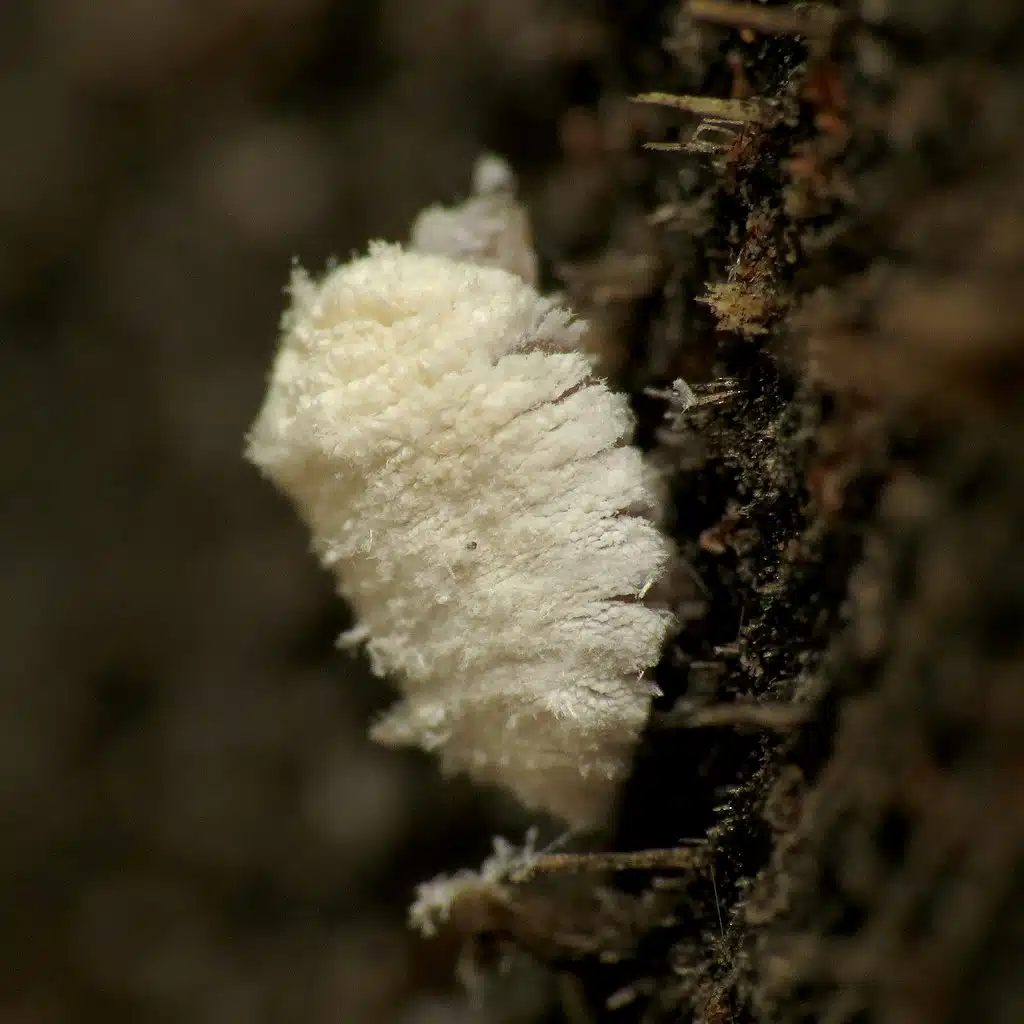
A waxy-fuzzy appearance is specific to The Planthopper Parasite Moth Caterpillar (Fulgoraecia exigua).
This species has light green coloring while a white waxy texture grows on its body as soon as it moves from one instar to another.
Only its green head is visible out of its waxy texture that covers the rest of its body.
The appearance of this caterpillar mimics its most common food, planthoppers. This is one of the rare caterpillars that eat small bugs.
17. Cabbage Tree Emperor Caterpillar
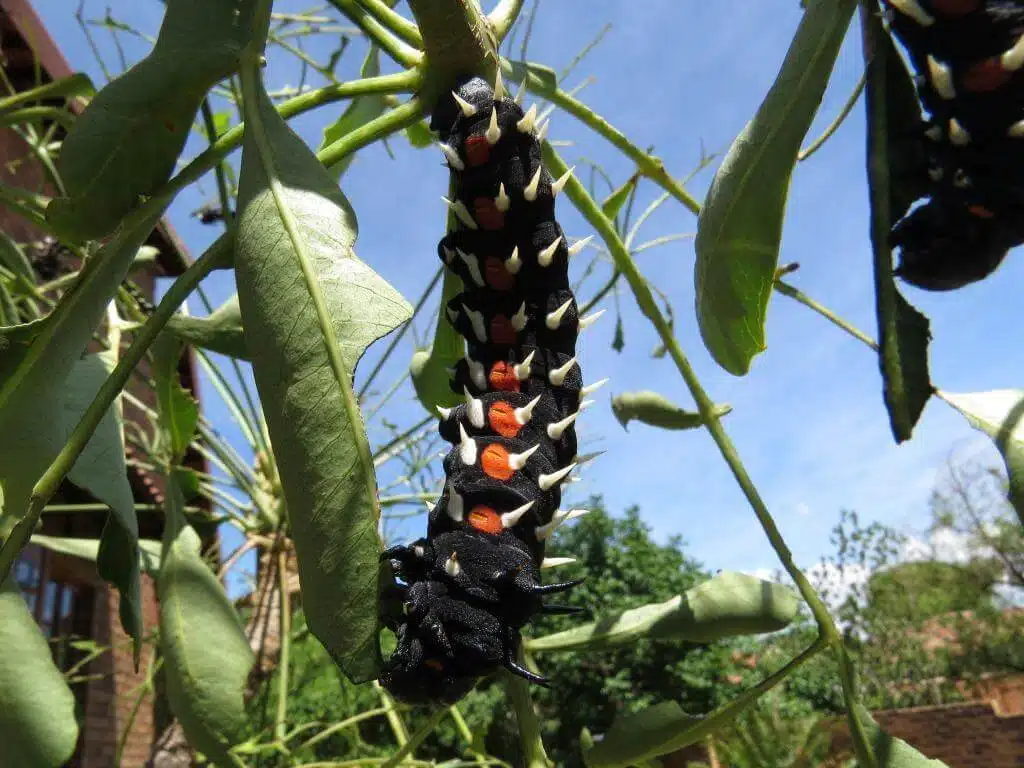
This African species (Bunaea alcinoe) is one of the rare black caterpillars of the world.
Initially, a white egg emerges as a black caterpillar which then starts to grow horns and tubercles.
Black horns are seen on the back of its head. 4 black horns on its head are longer than the shorter white horns on its body.
2 rows of shorter white horns are seen across its dorsum as the species grows.
Apart from these tubercles, the species also has wide red spots on its back. These red spots are located on the mid-back, between the rows of white horns.
18. White Commodore Caterpillar
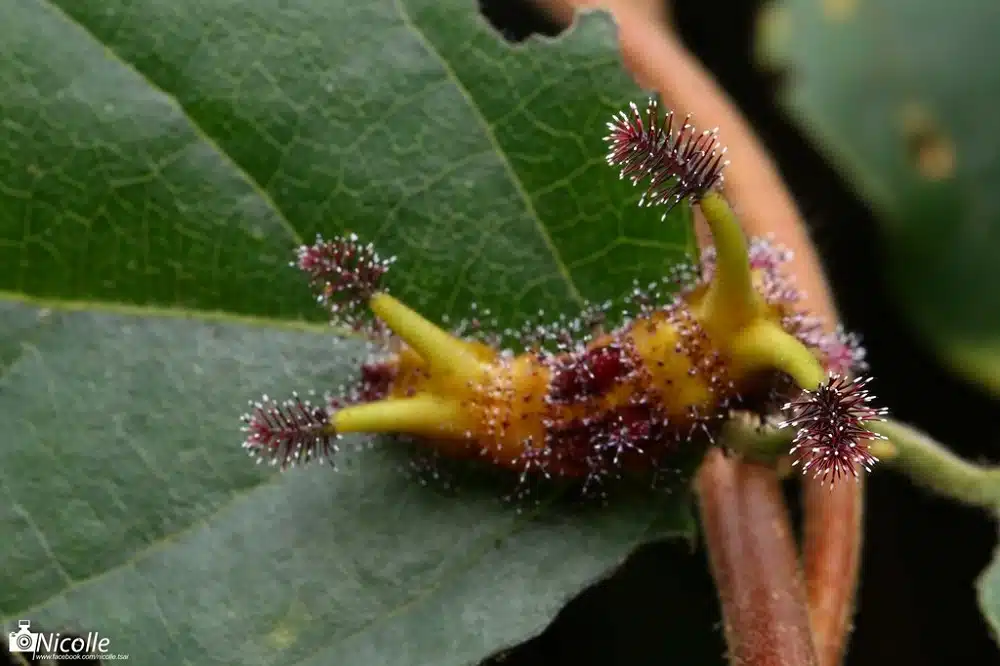
A spiny appearance is specific to the White Commodore Caterpillar (Parasarpa dudu).
Red and white colors are specific to this species, together with yellow.
The irregular shape of the caterpillar is atypical. Its body is yellow but it can rarely be seen due to the numerous red spines across its body.
These spines are grouped, and they resemble small globular shapes along its body.
Black and white tips are seen on these spines.
The White Commodore Caterpillar uses a plant flower mimicry technique to avoid predators. Its wasps help keep predatory wasps away.
19. Painted Cup Moth Caterpillar
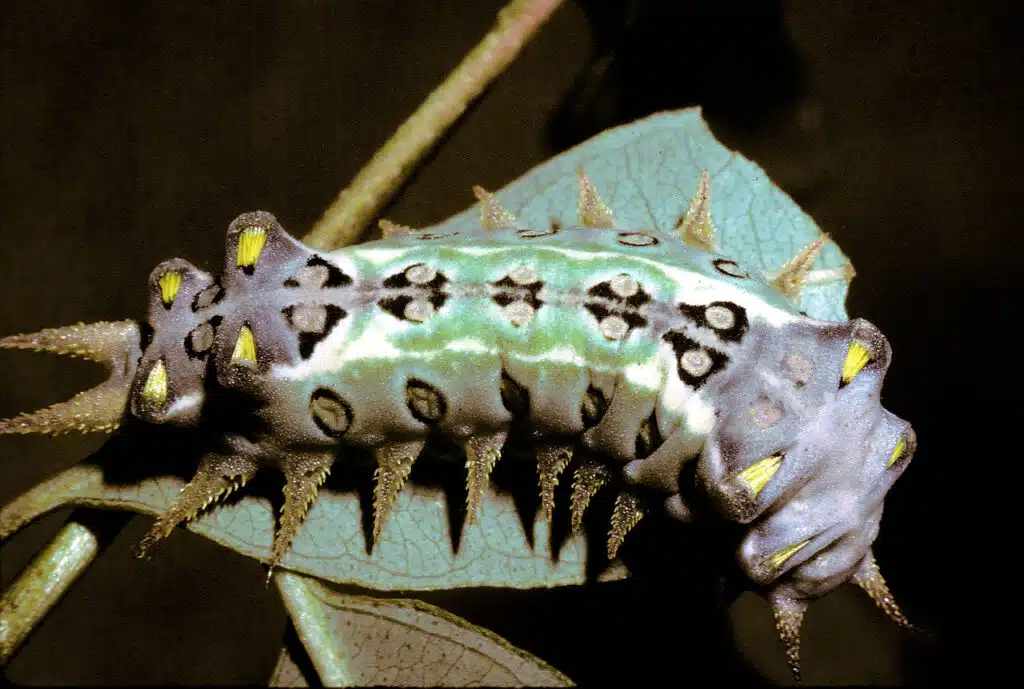
This beautiful caterpillar (Doratifera oxleyi) lives in tropical and subtropical climates.
Much of its presence is attributed to the presence of eucalyptus, the plant it feeds on the most.
This is a species with white to transparent sides and tubercles that point laterally from its body.
Its dorsal area is colored and it includes yellow, green, and red colors.
2 long frontal spines that are red are also present on the species, similarly to horns.
The species changes its coloring dramatically in its last instar. It becomes green and yellow, also showing yellow and black spots across its body and switching away from its slightly transparent appearance.
20. Epistrophus White Morpho Caterpillar
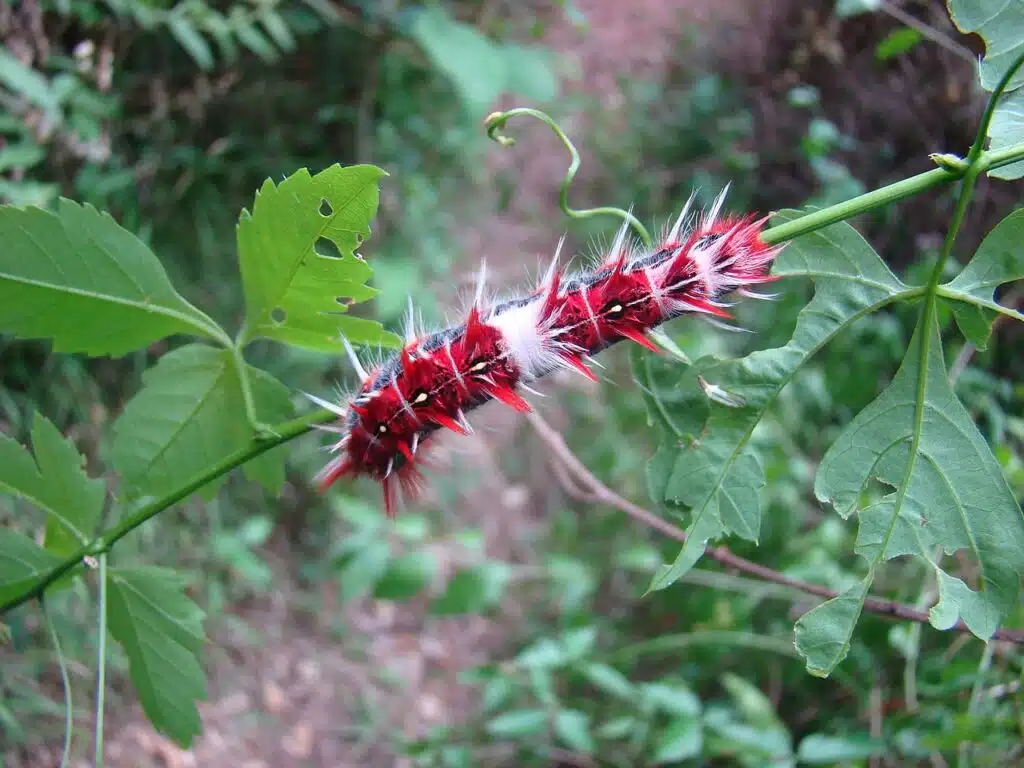
A hairy red body is specific to this type of caterpillar (Morpho epistrophus).
Unique by appearance, the caterpillar has vivid red hairs that cover most of its body, including its ventral side.
This is a caterpillar species that has a black body, sometimes visible through its red hairs.
Its black body has a thin yellow mid-dorsal stripe dedicated to yellow spots.
White hairs are seen towards the rear end of the species.
A contrasting species, this beautiful caterpillar is often passed by predators as red and yellow signal potential wildlife toxicity.
21. Superb Cycadian Caterpillar
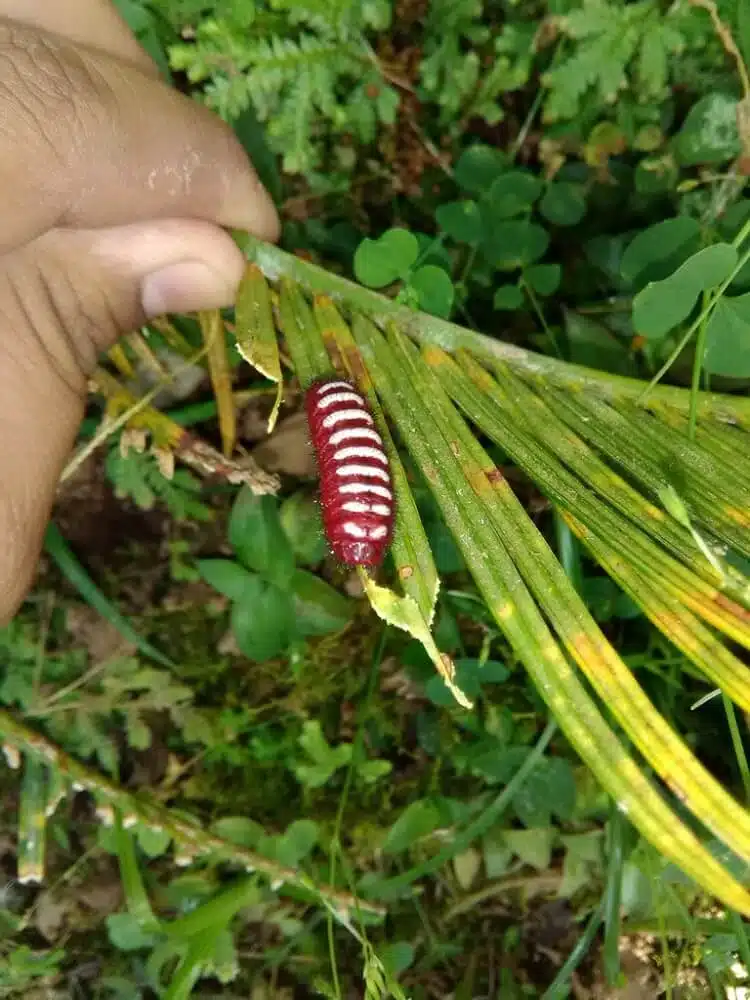
Ceratozamia Mexicana is the host species of this caterpillar (Eumaeus childrenae) that lives in warm tropical climates.
The species has a rare host but its appearance is also distinct.
The mostly red color is specific to this caterpillar. It has an emerald-red color with black undertones.
Multiple white dorsal bands run from the head to the rear end of the species.
Aposematic coloring makes this caterpillar widely overlooked by predators which consider it toxic or poisonous and move along to other food sources.
22. Megalopyge lanata
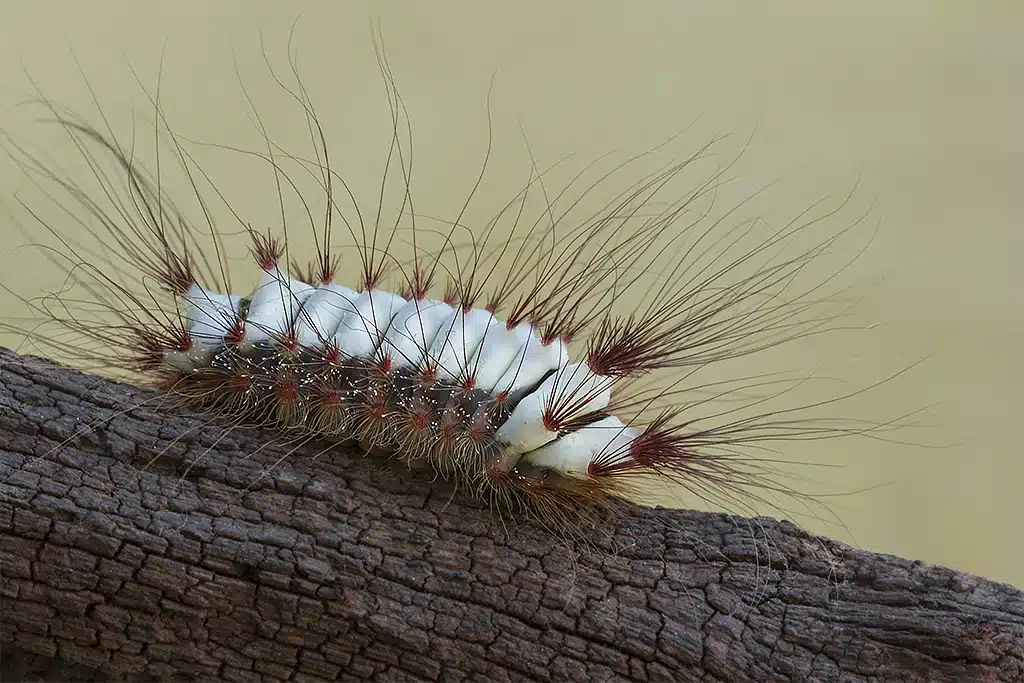
A multicolored weird appearance is specific to this caterpillar.
Its upper side is brighter while its lower side is dark gray with tiny white dots along the sides.
A white dorsal color is specific to the species. The body of the species is heavily segmented.
Long hairs are also seen across its body, even if scarce compared to other hairy caterpillars.
Red-brown colors are specific to the base of these hairs. Some of its long hairs may also be red at the base.
23. Norape virgo
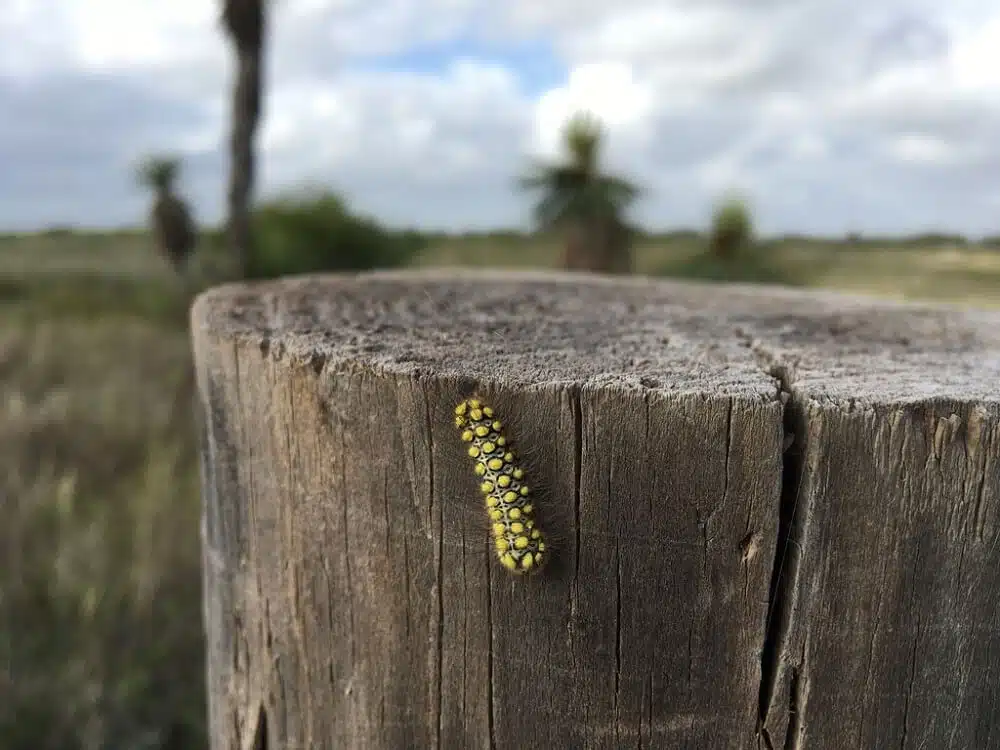
This caterpillar goes through different colors and color combinations as it grows.
A cute species at first, it has a green base color with a few black dots along its body.
It has yellow-green coloring with yellow dots that feature black borders all along its body in its early growth stages.
This caterpillar turns black in its last instars. Its colorful round spots also turn red, from an initial yellow color.
White stripes and white sections along its spots on the back are also specific to the late instar caterpillar.
24. Shag Carpet Caterpillar
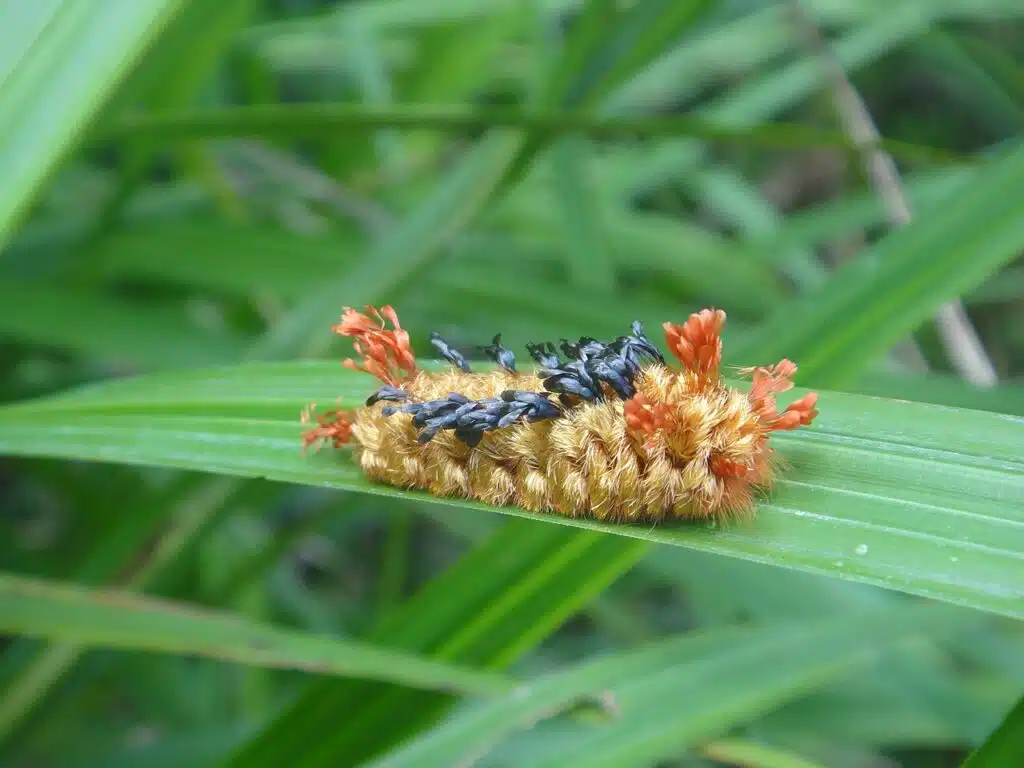
A fuzzy feathery-like appearance is specific to this Central and South American species.
Caterpillars of this genus have long hairs and feather-like formations on their dorsal side.
White tubercles on its back are backed by black hairs on its sides.
Its lower sides and ventral side are red. A metallic red nuance is specific to the underside of the Shag Carpet Caterpillar (Prothysana felderi).
Feeding on different types of outdoor and nursery plants, this caterpillar stands out immediately on the green leaves it lives and feeds on.
25. Daring Owl-Butterfly Caterpillar
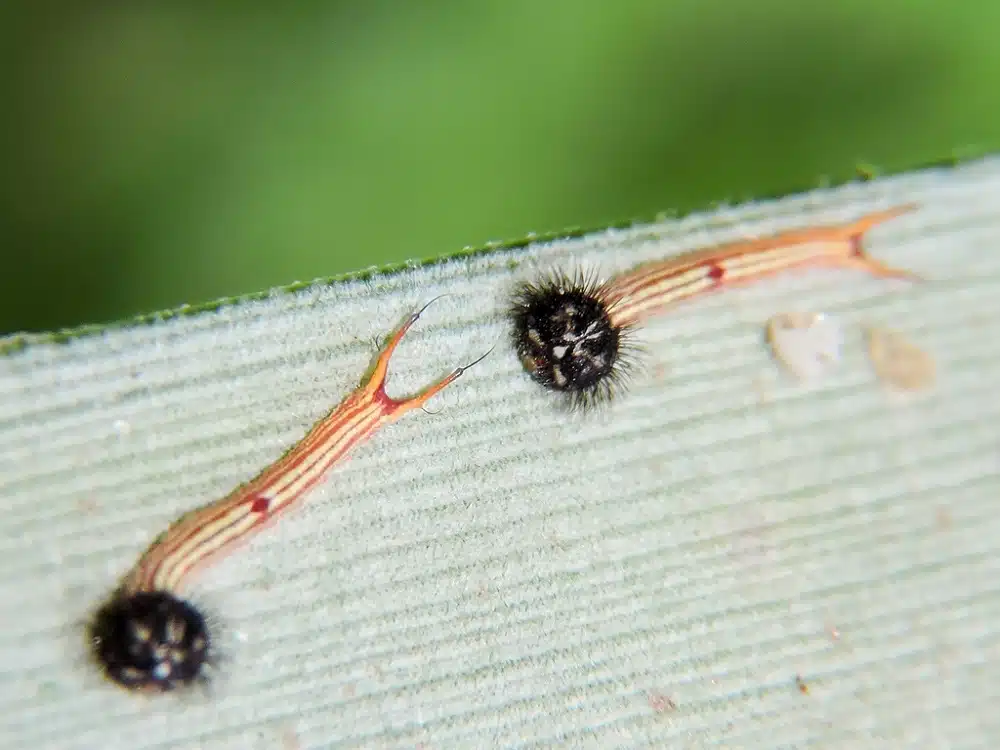
An atypical shape and color are specific to the weird Daring Owl-Butterfly Caterpillar (Dynastor darius).
A golden-brown dorsal color is specific to the species. Black legs and black tubercles that resemble legs are seen in the species.
This type of caterpillar may be compared on confused with spiders in its early instars.
Its body elongates from a round shape to a cylindrical shape as it grows.
Its head becomes black while its body becomes green with long brown and black cerci.
Much of its coloring is determined by mimicry techniques. This caterpillar turns into a brown pupa that mimics dead leaves.
26. Spotted Apatelodes Moth Caterpillar
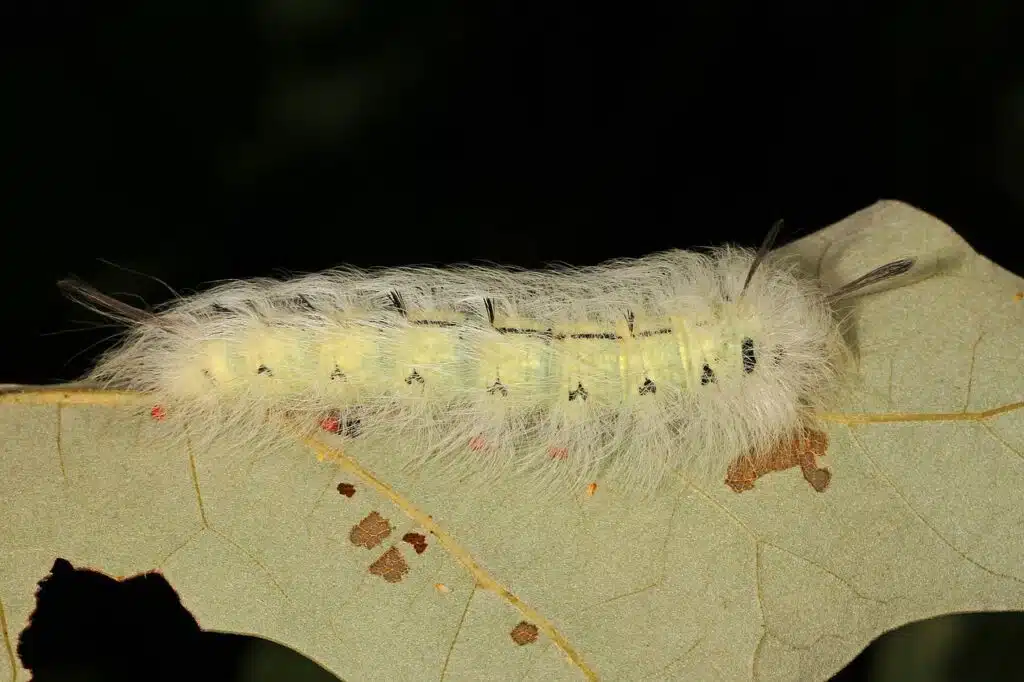
Often seen in oak woodlands or feeding on ash leaves, The Spotted Apatelodes Moth Caterpillar (Apatelodes torrefacta) lives in the Eastern US states.
This is a species that comes in either white or yellow coloring.
A white morph with white hair is specific to this caterpillar.
Yellow to green coloring is also seen on this caterpillar in a morph entirely covered in long hairs. These long hairs may also allow its white body with black stripes to be visible at times.
Brown tufts further decorate the body of this species.
27. Monarch Caterpillar
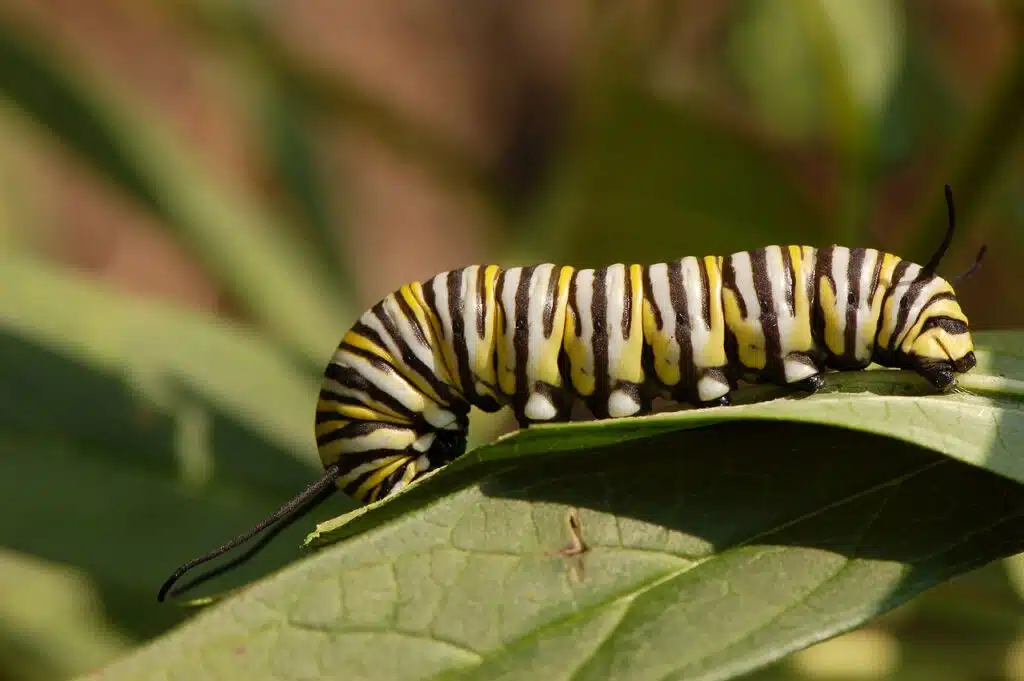
One of the most common beautiful moths in North America is the Monarch Caterpillar (Danaus plexippus).
Butterflies of the species are colorful and travel long distances to lay eggs and find an ideal habitat for their caterpillar.
A similar colorful body is also seen on the Monarch Caterpillar.
Black, yellow, and white alternating bands across its body.
Repeating transverse bands make this caterpillar easy to identify, together with its common nature.
28. Zebra Longwing Caterpillar
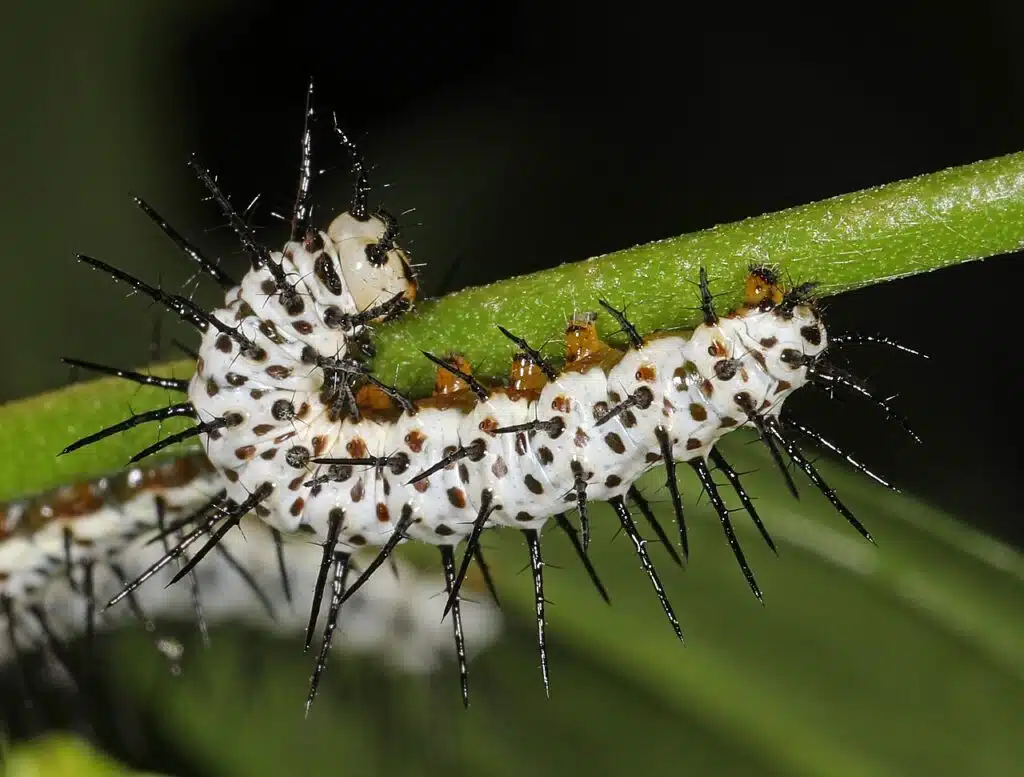
Contrasting colors are specific to the Zebra Longwing Butterfly (Heliconius charithonia). This is also the same for its caterpillar.
The lifecycle of the species starts with yellow or mustard-yellow eggs.
These eggs hatch for a white caterpillar to emerge.
As it grows, the Zebra Longwing Caterpillar starts to show black dots across its body. Long thin black spines also cover its body.
Alternating black and yellow colors may act to protect this species from its predators.
The species can easily be spotted on host plants such as those in the passionflower genus.
29. Pipevine Swallowtail Caterpillar
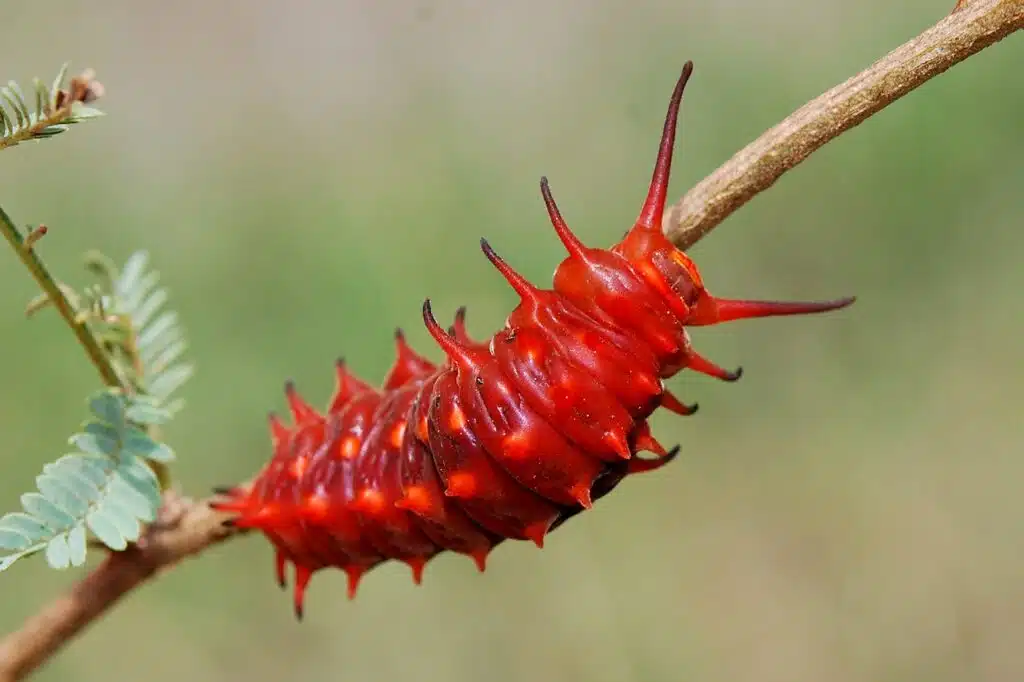
A dark orange color is specific to the early instar Pipevine Swallowtail Caterpillar (Battus philenor).
This is a species that grows to a size of up to 2 inches, also changing its coloring from one instar to another.
It darkens to a brown or red-brown color with orange tubercles in its later instars.
Dark brown coloring is specific to the later instar caterpillar which also shows contrasting short and rounded orange tubercles.
From here, the caterpillar goes into a green or a brown pupae which resembles a living or a dead rolled leaf.
30. Spicebush Swallowtail Caterpillar
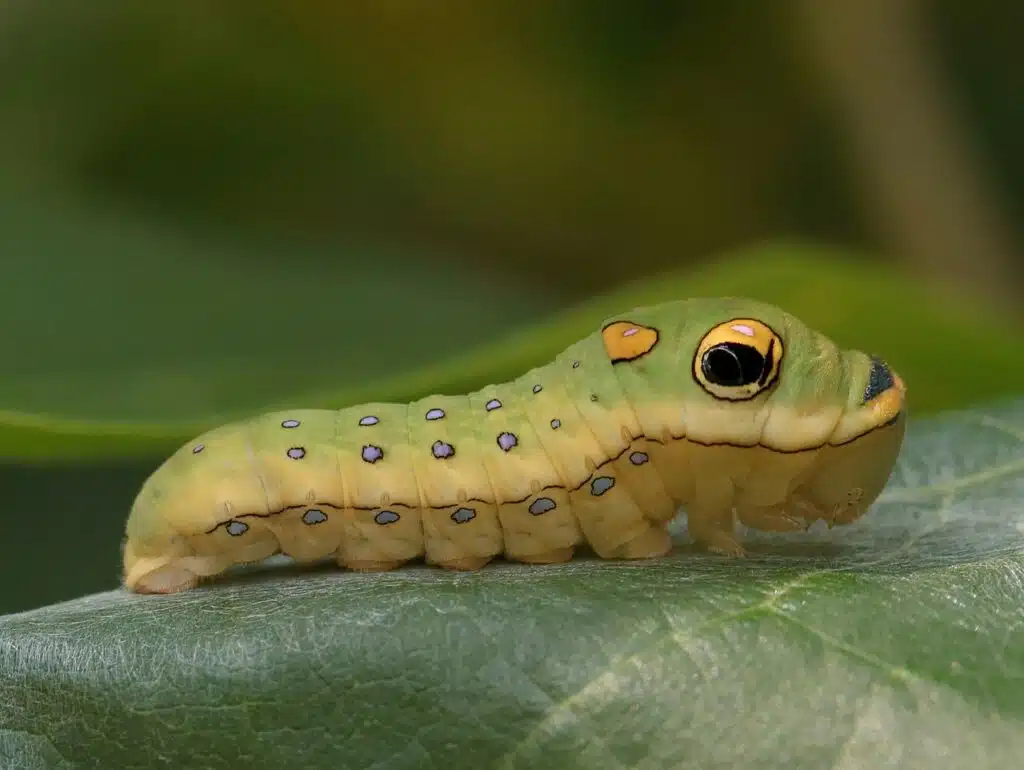
This type of caterpillar (Papilio troilus) goes through 2 mimicry stages as it grows.
One of the cutest caterpillars in North America, this small species evolved to use coloring to help itself in front of predators.
A brown color is specific to its initial growth stages.
A larger head with 2 large eyespots is seen on the back of its head. Its initial brown color mimics bird droppings.
This species slowly turns green, with yellow ventral coloring.
Its later instar green coloring comes with large black eyespots as well. These eyespots may make it appear similar to a small snake.
Tiny blue dots across the dorsum are also seen on the caterpillar in its last instar.
Growing on spicebush, this caterpillar goes through an intermediary yellow color as it turns green from an initial brown color.
31. Isabella Tiger Moth Caterpillar
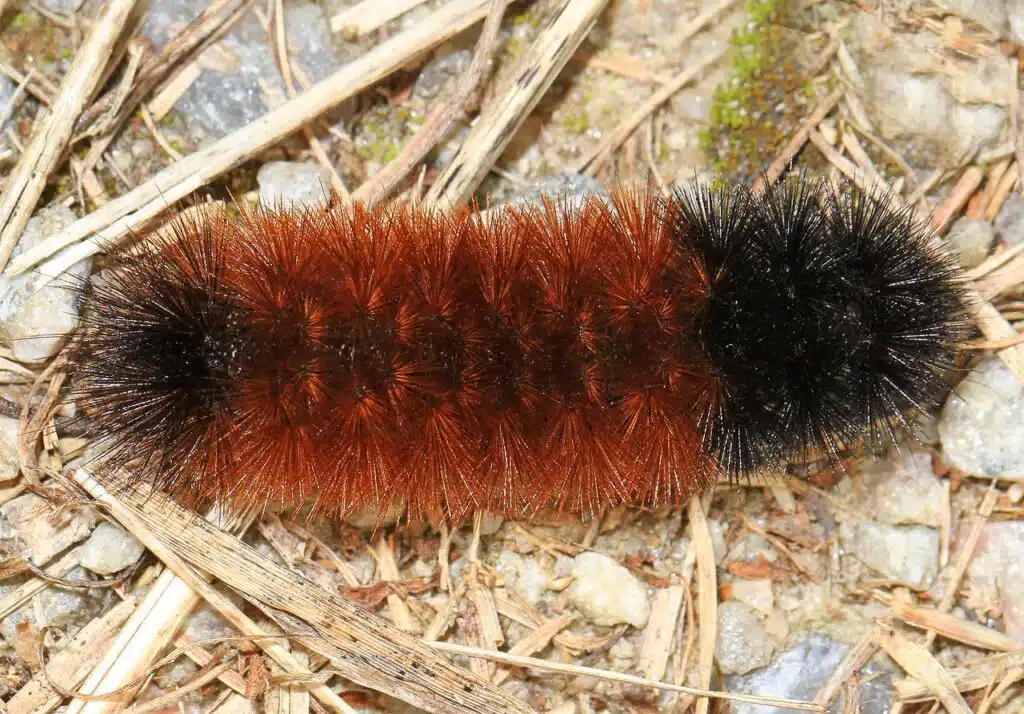
A bicolored body is specific to The Isabella Tiger Moth Caterpillar (Pyrrharctia isabella).
Brown and black colors and a hairy body are specific to this caterpillar.
Its central section of the body is brown while the ends are black.
Covered in short spiny hairs, The Isabella Tiger Moth Caterpillar should not be handled with bare hands.
Dermatitis is one of the extreme reactions to touching hairs.
While many assume its spiny hairs are venomous, there are no venom glands connected to these hairs.
No serious injury can be caused by handling this species with bare hands.
32. Virginian Tiger Moth Caterpillar
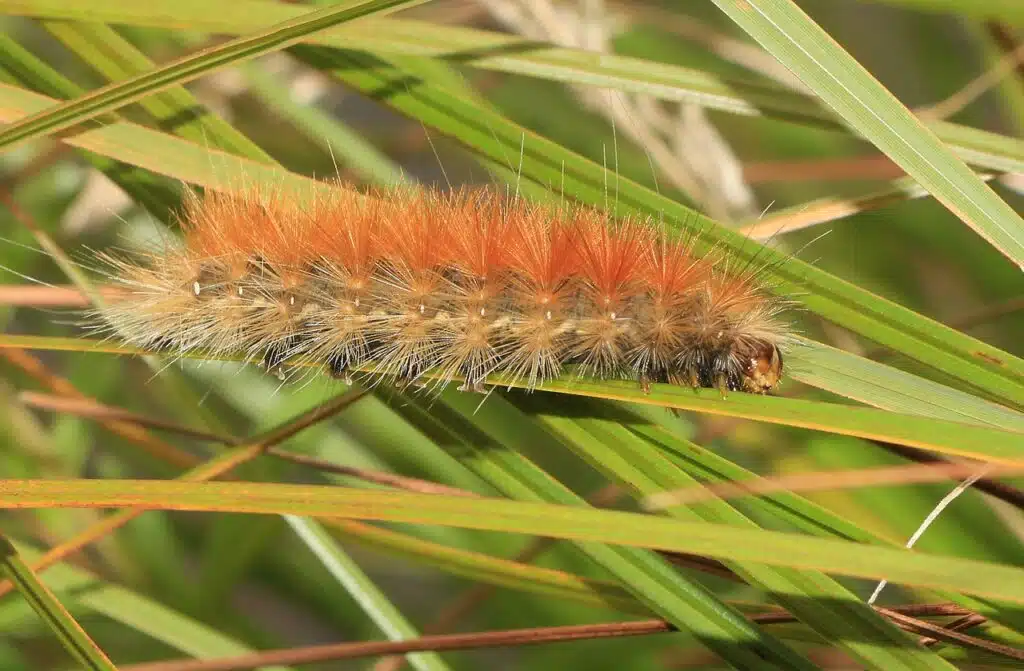
The Virginian Tiger Moth Caterpillar (Spilosoma virginica) is one of the most common beautiful caterpillars in North America.
A species known for its uniform yellow color, the caterpillar maintains its color from an early instar to a late instar.
Its body is covered in long dense yellow hairs. This is a species that has similar colored hairs and bodies.
The common nature of the species is given by its choice of host plants.
These are low-growing plants including grass. As a result, the caterpillar is a common sight when out hiking or camping.
Its appearance changes completely when it emerges as an adult as the Virginian Tiger Moth is white.
33. Cecropia Moth Caterpillar
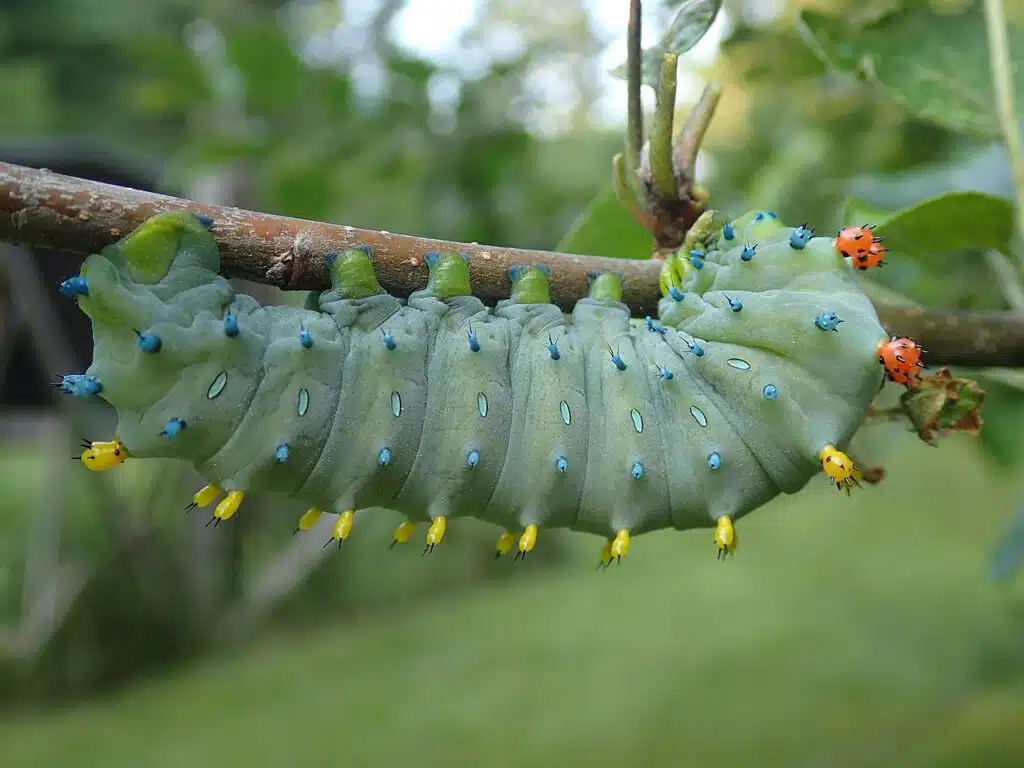
Atypical coloring is specific to the weird Cecropia Moth Caterpillar (Hyalophora cecropia).
Unlike other species that darken when they grow, these caterpillars brighten as they grow.
The caterpillar has an all-black initial appearance with tubercles all across its body.
The second and third instars are marked by a color change in this species.
Yellow and then green color phases are specific to the species.
The last instar caterpillar has a pale green color with blue or yellow tubercles.
Its pale green color has blue undertones, giving this caterpillar a beautiful distinct appearance from most other vivid green caterpillars.
34. Regal Moth Caterpillar
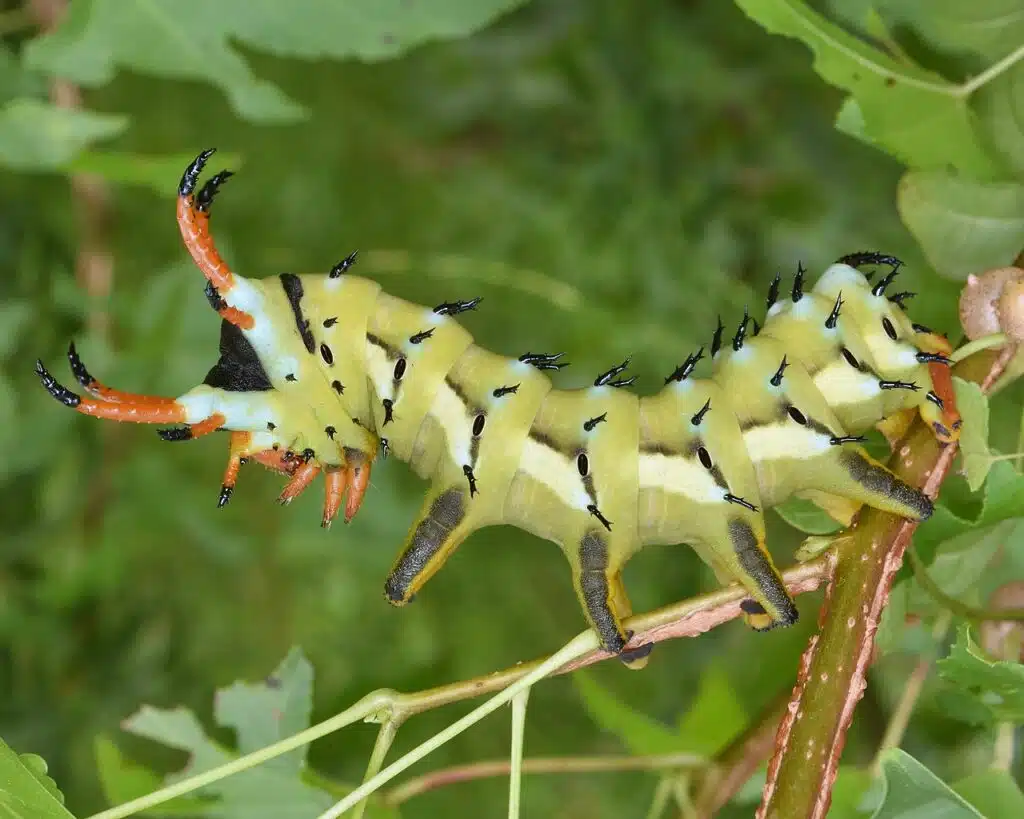
Found in woodlands across the Southern US states, Regal Moth Caterpillars (Citheronia regalis) also change their appearance as they grow.
This is a species that has a vivid green color with yellow and black bands contrasted by yellow and black prolegs.
As it grows, the species starts to darken as it also loses the yellow sections along its body.
It becomes green-gray or green-blue with short black spines. The back of its head is also where 4 brown and black horns are visible in its final instars.
The rear horns of the Regal Moth Caterpillar split into 2 sets of horns.
35. Puss Caterpillar
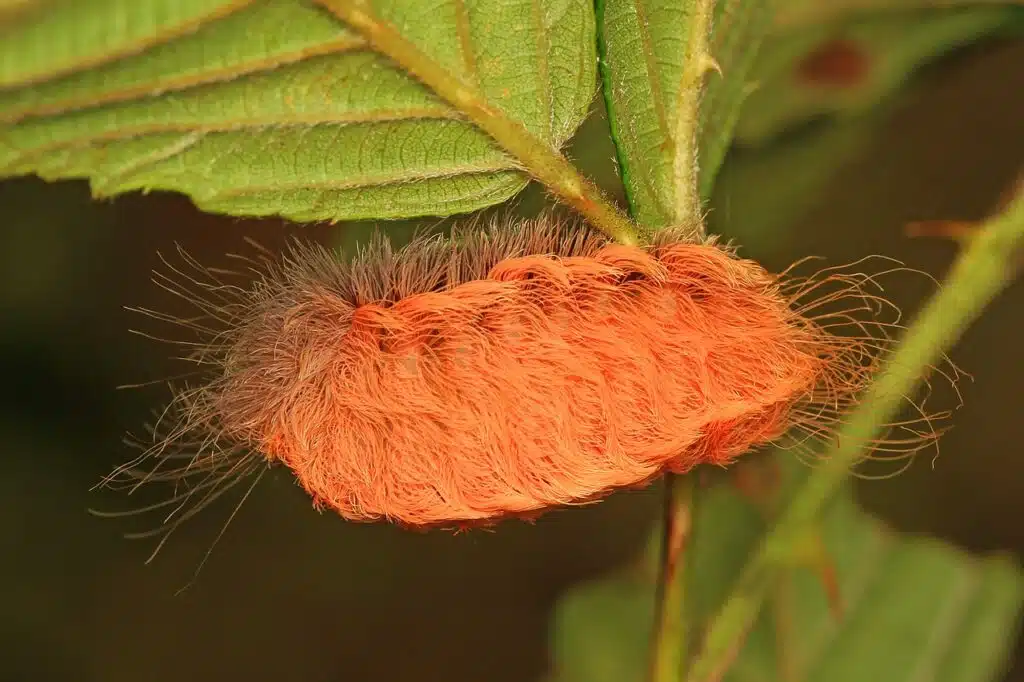
This (Megalopyge opercularis) is a species also referred to as an Asp caterpillar in some North American regions. The Puss Caterpillar has a weird hairy appearance.
Its body is entirely covered in hair-like spines. While soft, its spines are hollow and venomous.
The venom travels from venom glands at the base of the spines upwards, towards the tip of the spines upon contact.
Serious skin reactions such as rashes and dermatitis are possible when the caterpillar is handled.
Puss Caterpillars are further identified by their brown-gray color, which camouflage themselves on oak and elm tree bark, as well as on other trees as they feed on their leaves.
An atypical hairy body is also specific to the Puss Moth.
36. Evergreen Bagworm
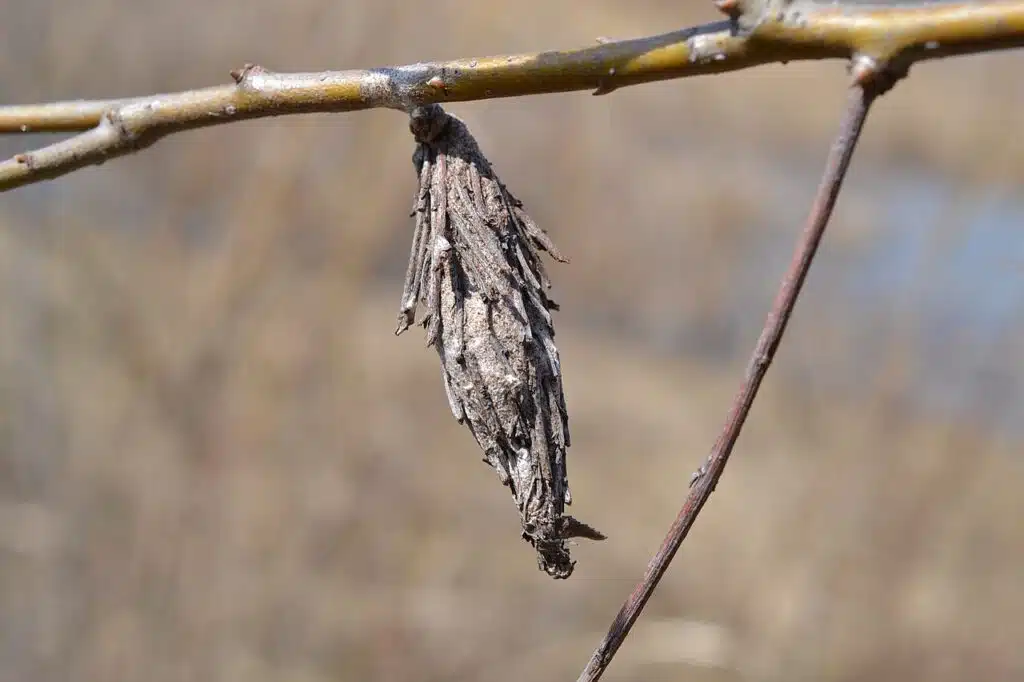
This type of rare caterpillar (Thyridopteryx ephemeraeformis) is one of the smallest caterpillars in the world. It measures just 2mm in its first instar.
This is a species that builds a bag-like case around itself. It uses various vegetation fibers to build this protective case around it.
A brown color is specific to the caterpillar throughout most of its instars. It turns black just before pupation.
Some of its common hosts include juniper. Other hosts of the species also used by other caterpillars include Red oak and willow.
37. Saddleback Caterpillar
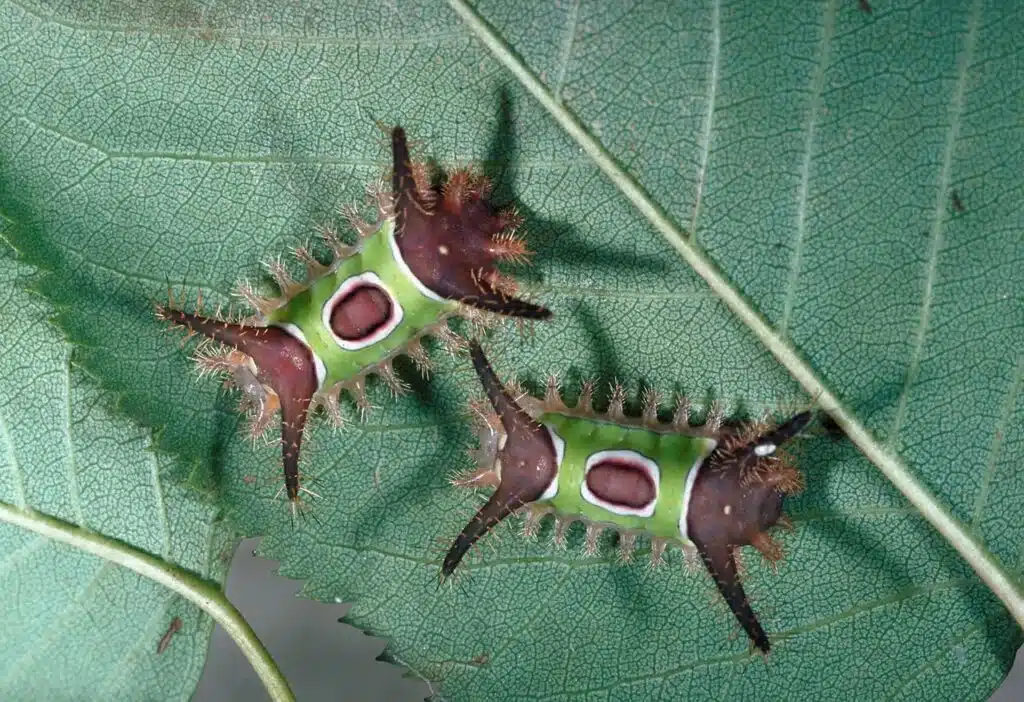
As its name implies, The Saddleback Caterpillar (Acharia stimulea) is a species dominated by its colored saddle-like formation in the mid of its body.
This is a species with a green saddle-like coloring on its body. Brown ends are specific to the caterpillar.
Short spines grow on these brown ends of its body.
This species has no prolegs. It moves similarly to slugs.
Mucuses are used by the caterpillar to move, albeit at a slower rate compared to other caterpillars.
Sucking movements may also be used by the caterpillar to move around.
Its slow movements and its colorful body may make it a common sight in North America.
The species is seen on basswood, chestnut, false buckthorn, and other trees or plants.
38. Showy Emerald Caterpillar
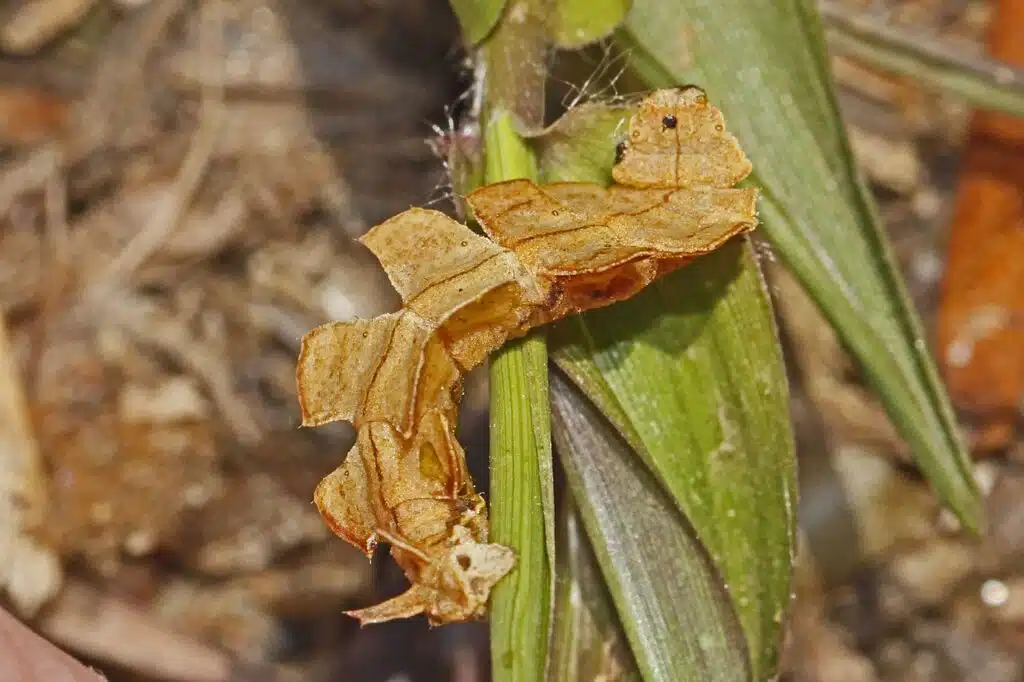
The Showy Emerald Caterpillar (Dichorda iridaria) is one of the weirdest species of caterpillars in North America.
Eastern and coastal US states are its main habitat, together with the Southeastern parts of Canada.
This is a caterpillar marked by mimicry tactics.
A light brown color is specific to the species, which is also covered in tiny brown spots and has a lateral dark brown stripe.
The shape of the caterpillar makes it look atypical.
Seen from above, it has an irregular shape with multiple wide and square projections from its body.
These projections and the brown color of the species make it resemble dead oak leaves, but with square ends instead of rounded ends.